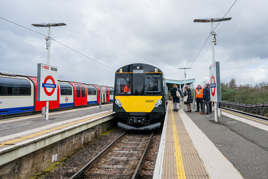Great Western Railway’s ‘fast-charge’ battery train, 230001, is undergoing a 12-month trial on the Greenford branch in west London, to assess its technology and consider whether it could be used on other lines.
The train has shoegear underneath that allows it to recharge on-board batteries from a larger bank of batteries held in two storage containers at West Ealing.
These batteries then draw power from the National Grid on a trickle basis.
GWR Managing Director Mark Hopwood explained that research from the trial would help GWR understand what was needed to roll out this technology onto Thames Valley branch lines and those in Devon and Cornwall.
GWR Engineering Director Simon Green told a media briefing that the fast-charge technology was being used for the first time in Britain - and possibly the world.
He said it was the result of an enormous amount of work involving GWR engineers, Network Rail and the Department for Transport, with the GWR engineers having transferred across from Vivarail, which first developed the idea but then went bankrupt.
The system uses three short power rails installed in the four-foot between a track’s running rails.
The centre rail supplies the positive voltage.
As 230001 approaches, it automatically lowers two shoes and they run onto the centre and one side power rail.
Electricity then flows when the train has stopped.
The power rails remain electrically dead and earthed until 230001 is directly over them, reducing the risk of electrocution should anyone touch the rails without the train there.
The rails recharge the train’s batteries at 750V direct current (DC), with a current of up to 1,000 Amps.
The three-car 230001 has two battery cars, so West Ealing is equipped with two sets of charging rails. Each can supply power at up to one megawatt (1MW), giving 2MW in total.
* More on this story in Issue 1006 of RAIL magazine. Get your copy delivered to your letterbox or inbox.

















Login to comment
Comments
No comments have been made yet.